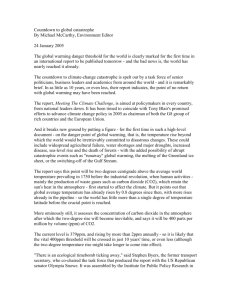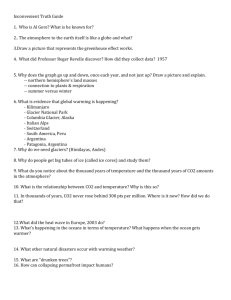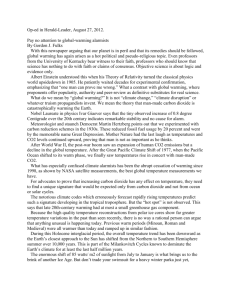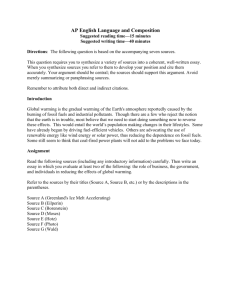Six Degrees
advertisement
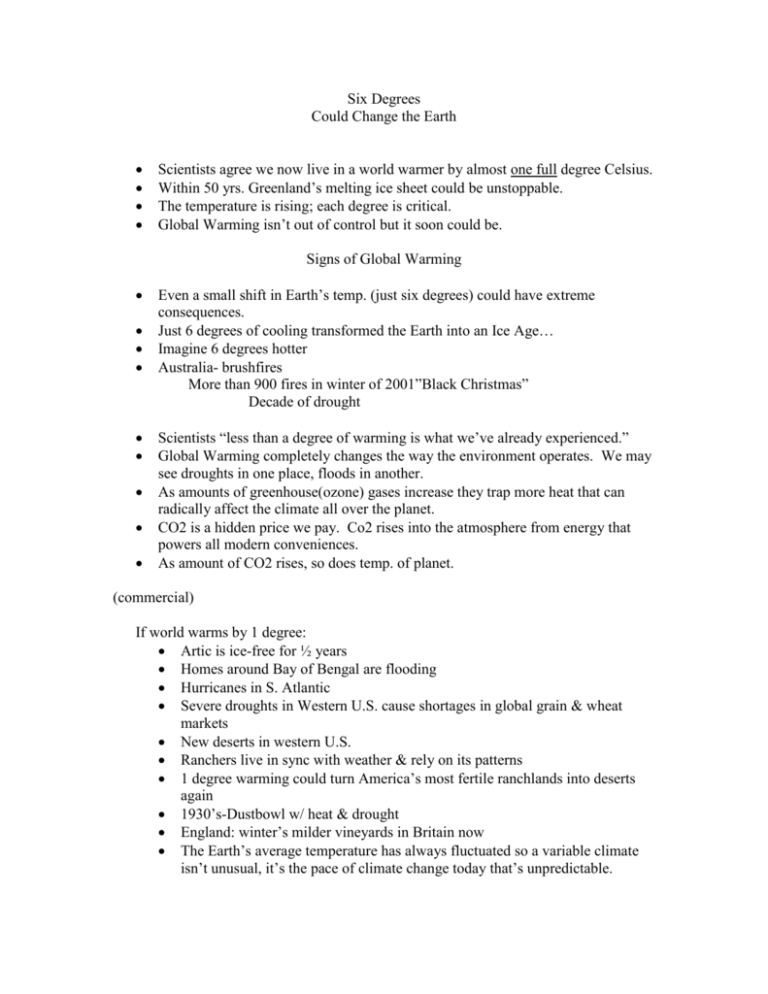
Six Degrees Could Change the Earth Scientists agree we now live in a world warmer by almost one full degree Celsius. Within 50 yrs. Greenland’s melting ice sheet could be unstoppable. The temperature is rising; each degree is critical. Global Warming isn’t out of control but it soon could be. Signs of Global Warming Even a small shift in Earth’s temp. (just six degrees) could have extreme consequences. Just 6 degrees of cooling transformed the Earth into an Ice Age… Imagine 6 degrees hotter Australia- brushfires More than 900 fires in winter of 2001”Black Christmas” Decade of drought Scientists “less than a degree of warming is what we’ve already experienced.” Global Warming completely changes the way the environment operates. We may see droughts in one place, floods in another. As amounts of greenhouse(ozone) gases increase they trap more heat that can radically affect the climate all over the planet. CO2 is a hidden price we pay. Co2 rises into the atmosphere from energy that powers all modern conveniences. As amount of CO2 rises, so does temp. of planet. (commercial) If world warms by 1 degree: Artic is ice-free for ½ years Homes around Bay of Bengal are flooding Hurricanes in S. Atlantic Severe droughts in Western U.S. cause shortages in global grain & wheat markets New deserts in western U.S. Ranchers live in sync with weather & rely on its patterns 1 degree warming could turn America’s most fertile ranchlands into deserts again 1930’s-Dustbowl w/ heat & drought England: winter’s milder vineyards in Britain now The Earth’s average temperature has always fluctuated so a variable climate isn’t unusual, it’s the pace of climate change today that’s unpredictable. Planet Exp. Climate changed before but usually over thousands of years. Now, Global Warming is measured in decades, even years. 2 degrees: Greenland’s glaciers are disappearing. Polar bears struggle to survive. Insects migrate in strange and new directions. Pine bark forests are killed off. Forests in Canada’s tundra. Pacific islands are lost due to rising tides. Lose vast majority of Earth’s tropical coral reefs. Bleaching of Great Barrier Reef corals. More than 1 million different species live and breed around reefs. Oceans are planets largest carbon sink-nature’s primary mechanism for absorbing CO2. Too much CO2 turns ocean water acidic. (commercial) Rising oceans will flood coastal cities around the world. Greenland’s ice sheet is melting twice as fast as a decade ago. In just 2 days, enough ice to supply water for New York area for 1 year. With ice melting in Greenland, sled dogs are too great an expense many are starving, some are being put down; Now that is a thing of the past. Scientists once a year, fly to Greenland’s interior to listen to ice. Swiss Camp built into glacier to study climate change. 23 weather stations, updating global warming computer models all over the world. 1992- 3.5 miles of glaciers slipped into sea. 2002(10 years later) # more than doubled – (7.8 miles annually) Rivers of melted ice go straight down into glaciers creating huge tunnels called Malians. Cuts through to bedrock. Melting is happening so rapidly now oceans could rise as much as 3 or 4 feet over the next century. Scientist- Greenland’s ice sheet contains enough frozen water to raise sea level 7 metersflood London, Bangkok, Shanghai, and NY. 2 degrees of warming is “Tipping Point” that will fundamentally change how we live on this planet. Warming accelerates loss of polar ice, loss of ice acc. Warming. The warmer it gets, the faster it gets warmer- that’s when Global Warming becomes a chain reaction we can’t easily predict. (commercial) Global Warming started with our insatiable appetite for energy. Nearly 90% of the world’s energy starts as a fossil fuel- coal, oil, nat. gas. Chemistry of burning fossilized remains of prehistorical plants& animals is inescapable (CO2). These fuels have enhanced quality of life for generations. Carbon footprint means all energy consumed every step of the way to make the product. Another critical part of greenhouse gas footprint- methane (from cattle). Methane=23 units of CO2. 200 million metric tons (just from U.S. cheeseburger). Everyday activities are critical aspect of human impact of global warming. +3 Degrees Arctic’s ice free all summer. Amazon rainforests drying out. Snow caps on Alps disappear. El Nino weather patterns become status quo. Mediterranean parts of Europe within summer heat. 2003-Red flag warnings about heat caused people in Paris to die from heat wave. 30,000 died in Europe, 14,000 died in Paris. (commercial) +3 Degrees (continued) Climate change could be manifest in the most violent weather humans have ever experienced. Ocean currents would change. Trade winds weaken. Flooding in S. America. Turbo change super storms. 2005: Hurricane Katrina Dropping pressure in eye wall & 85 degrees water temp. increased storm’s fury. Category 6 hurricanes may be possible. Beyond 3 degrees, science of global warming more & more speculative & more & more frightening. (commercial) +4 Degrees Oceans rise overtaking deltas- home to over a billion people.
